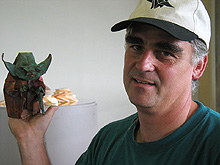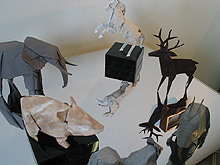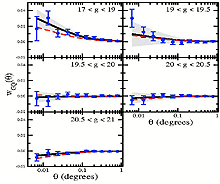 | Wednesday, September 7, 2005 |
|
Wednesday, September 7 11:00 a.m. Fermilab ILC R&D Meeting - 1 West Speaker: S. Mishra, Fermilab Title: Summary of the Snowmass Accelerator Workshop 3:30 p.m. Director's Coffee Break - 2nd Flr X-Over 4:00 p.m. Fermilab Colloquium - 1 West Speaker: T. Newman, University of California, San Francisco Title: The Power of Stories Over Statistics: Illustrations from Neonatal Jaundice and Infant Airplane Safety
Thursday, September 8 |
|
Extended Forecast |
Secon Level 3 |
|
Wednesday, September 7 - Portabello Harvest Grain - Santa Fe Chicken Quesadilla - Garlic Herb Roasted Pork - Beef Stroganoff - Maryland Crab Salad - Meatlover's Pizza - Pesto Shrimp and Linguini with Leeks and Tomatoes The Wilson Hall Cafe now accepts Visa, Master Card, Discover and American Express at Cash Register #1. |
|
Wednesday, September 7 Lunch - Salmon w/Ginger Scallion Mayo - Snow Peas & Carrot Salad - Poached Pears w/Vanilla Ice Cream & Chocolate Sauce
Thursday, September 8
Chez Leon Menu |
| Fermilab Today is online at: http://www.fnal.gov/today/ Send comments and suggestions to today@fnal.gov Fermilab Today archive Fermilab Today PDF Version Fermilab Result of the Week archive Fermilab Safety Tip of the Week archive Linear Collider News archive Fermilab Today classifieds Subscribe/Unsubscribe to |
| Much More than Paper Cranes: Origami Art Comes to Fermilab |
||
|
||
|
Check out the new art exhibit on the second floor of Wilson Hall, and you'll be in for a treat. From smiling metal Yodas to strolling paper hermit crabs, Fermilab's new origami art installation, which will be on display until November 4, is anything but ordinary.
Artists Chris Palmer, Lane Allen and Robert Lang have folded intricate mesh and paper sculptures from flat sheets that, in some cases, started out over nine feet long. The artists use the same method many of us used to make cranes and party-hats in elementary school—with a series of precise folds. But these designs are not kid's stuff. The display includes a three-foot-tall folded-mesh dragon crouching over his young, for example, and an origami owl with detailed talons that appears to swoop down to catch her prey. "The first thing you learn in art school is that sculpture is either additive or subtractive [like construction vs. woodcarving]," explained artist Lane Allen, "but origami is unique in that it is neither of these. Instead, it is metamorphic." Unlike the other two artists in the exhibit (and the most of the origami world), Allen does not use paper as his medium. A self-declared "metal man," he folds copper and silver mesh into mythical creatures. And while his paper-based colleagues use water to make their sculptures more life-like, Alan uses chemicals that are a little stronger. His Yoda sculpture, for example, has been washed in a sulfate, so Yoda's copper body has an oxidized head that is green, while the rest of his body shimmers a brassy purple. Although origami is a complex and sometimes frustrating art form, Allen has a good reason for putting up with all the tedious folding: "I use origami to get people in touch with a mythical language that we all have, but we seem to forget in the course of a normal day." On October 6 and 7, the three Origami artists exhibiting at Fermilab will give presentations at Fermilab.
|
||
|
|
September 2 - September 5 - During the 72 hour period operations established three stores that combined with an existing store provided the experiments with 41 hours of luminosity - A bad vacuum card causes the loss of a Tevatron store
Read the Current Accelerator Update |
|
From The Register-Guard, September 5, 2005 UO Physicist Works on Collider Imagine a machine so powerful it can hurl objects into each other at just short of the speed of light, creating tiny explosions that release an amount of energy rarely seen in the universe since shortly after the Big Bang. Now, imagine a scientist from the University of Oregon helping build it. That's Jim Brau, a UO physics professor and co-leader of the International Collider Project, a worldwide effort to build the most sophisticated atom smasher ever, one that will allow scientists to peer so far back into the genesis of the universe it's become known as "Einstein's Telescope." If all goes well, work on the multibillion-dollar project could begin by 2010 in a location yet to be selected.
If and when the machine gets built, the collisions of electrons and positrons it creates could begin to answer some of the deepest mysteries of the cosmos, things such as the structure of dark matter, the existence of extra dimensions and the long-sought unifying "theory of everything."
|
| SDSS Measures Cosmic Magnification |
|
Albert Einstein became world famous in 1919, when Sir Arthur Eddington's observing campaign during a solar eclipse confirmed Einstein's prediction that gravity affects the path taken by light rays, i.e., that mass can act as gravitational lens. Today, astronomers routinely use gravitational lensing as a tool to determine how much mass there is in the universe, and how it is distributed. A team of astronomers led by U of C and Fermilab alumnus Ryan Scranton, now at the University of Pittsburgh, has analyzed the gravitational lensing of distant quasars by foreground galaxies in the SDSS. The experiment is basically a simple one: count how many quasars there are around galaxies, as function of the apparent magnitude of the quasar and of the distance from the galaxy acting as gravitational lens. Previous attempts to measure this galaxy-quasar cross-correlation signal had yielded results that were in conflict both with each other and with the theoretical predictions. Recent advances in the theory implied that the largest uncertainties were now due to observations of insufficient accuracies.
Scranton and his colleagues took full advantage of the major advance of the SDSS over previous large-area surveys: the use of CCDs instead of photometric plates improved the measurement errors on the fluxes of galaxies and quasars from 20-30% to 2-3%. These highly accurate measurements and the use of new statistical techniques in both galaxy and quasar selection made it possible to distinguish between stars in the galaxy, other galaxies and distant quasars using only the CCD imaging, without the need to perform time-consuming spectroscopy. In this way, the researchers created a sample of 13.5 million galaxies (compared to only 500,000 galaxies in the SDSS spectroscopic sample) and 195,000 quasars (compared to only 50,000 from the spectroscopic sample). In magnification, each galaxy acts as a gravitational lens; the effect from each lens is small, so a large number of lenses and sources is needed to measure the signal. Light from background quasars passing near galaxies is amplified, making the quasar brighter and increasing the number of quasars above a given flux threshold. But the light is also deflected, reducing the density of quasars on the sky. The first of these effects tends to positively correlate galaxy and quasar densities while second leads to an anti-correlation. The resulting signal combines these two effects, with the stronger being determined by the slope of the quasar number counts relation (i.e. do we gain enough quasars by going a bit fainter to make up for the quasars we lose from the dilution?). For bright quasars, the number counts relation is very steep, which should yield a positive correlation, while fainter quasars should be negatively correlated, thanks to shallower number counts. The results by Scranton et al. (accepted for publication in the Astrophysical Journal) confirm this prediction, for the first time creating an agreement between models and observations of cosmic magnification.
|
|
Ultimate Frisbee Interested in playing ultimate frisbee? It's a great way to get exercise while having fun at the same time! If you've never played before, don't worry about it, we'll teach you. Join us today at the soccer field in the village. We usually play every Wed. from 5:00 - 7:00 pm. Please bring a bottle of water. See you there!
Building Manager Notice
Fermilab Health Fair
Career Night
Picnic at Users Center
for WYOP Volunteers
|


